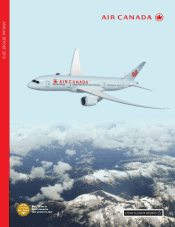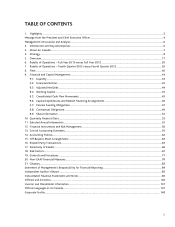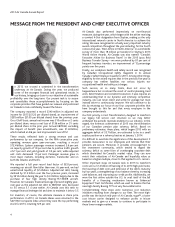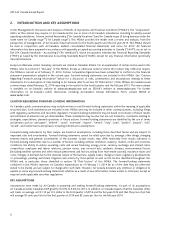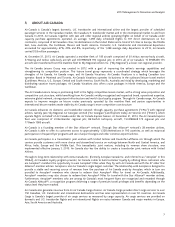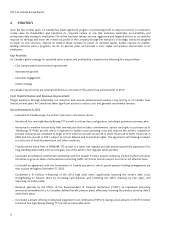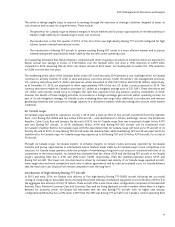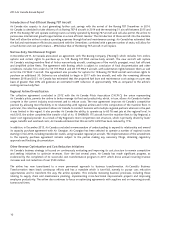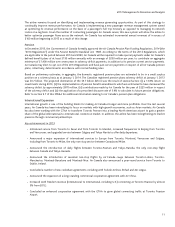Air Canada 2013 Annual Report Download - page 10
Download and view the complete annual report
Please find page 10 of the 2013 Air Canada annual report below. You can navigate through the pages in the report by either clicking on the pages listed below, or by using the keyword search tool below to find specific information within the annual report.2013 Air Canada Annual Report
10
Introduction of Fuel-Efficient Boeing 787 Aircraft
Air Canada also expects to start generating further cost savings with the arrival of the Boeing 787 Dreamliner in 2014.
Air Canada is scheduled to take delivery of six Boeing 787-8 aircraft in 2014 and the remaining 31 aircraft between 2015 and
2019. The Boeing 787 will operate existing routes currently operated by Boeing 767 aircraft and will also permit the airline to
pursue new international growth opportunities in a more efficient manner. The introduction of these aircraft into the mainline
fleet will allow the airline to reduce operating expenses through fuel and maintenance savings. Air Canada has estimated that
the fuel and maintenance efficiencies associated with the Dreamliner, combined with a greater number of seats, will allow for
a much better unit cost performance – 29% below that of the Boeing 767 aircraft it will replace.
Narrow-Body Fleet Renewal Program
In December 2013, Air Canada announced an agreement with The Boeing Company (“Boeing”) which includes firm orders,
options and certain rights to purchase up to 109 Boeing 737 MAX narrow-body aircraft. The new aircraft will replace
Air Canada’s existing mainline fleet of Airbus narrow-body aircraft, creating one of the world’s youngest, most fuel efficient
and simplified airline fleets. The agreement with Boeing, which is subject to conclusion of final documentation and other
conditions, includes firm orders for 33 737 MAX 8 and 28 737 MAX 9 aircraft, with substitution rights between them as well
as for the 737 MAX 7 aircraft. The agreement also provides for options for 18 Boeing 737 MAX aircraft and certain rights to
purchase an additional 30. Deliveries are scheduled to begin in 2017 with two aircraft, and with the remaining deliveries
between 2018 and 2021. Air Canada has estimated that the projected fuel burn and maintenance cost savings on a per seat
basis of greater than 20% will generate an estimated CASM reduction of approximately 10% as compared to the airline’s
existing narrow-body fleet.
Regional Airline Diversification
The collective agreement concluded in 2012 with the Air Canada Pilots Association (“ACPA”), the union representing
Air Canada’s pilots, permits the airline to better manage its fleet and productivity which, in turn, allows Air Canada to better
compete in the current industry environment and to reduce costs. The new agreement improves Air Canada’s competitive
position by allowing more flexibility in its relationship with regional airlines and in the composition of the mainline fleet. In
particular, the collective agreement allows Air Canada to conduct business with multiple regional partners whereas in the past
it was limited in this regard. It also provides Air Canada the ability to operate up to 60 76-seat jets at the regional level. In
mid-2013, the airline completed the transfer of all of its 15 EMBRAER 175 aircraft from the mainline fleet to Sky Regional, a
lower cost regional provider. As a result of Sky Regional’s more competitive cost structure, which is primarily driven by lower
wages, benefits and overhead costs, Air Canada estimates that this aircraft’s CASM has been reduced by 11%.
In addition, in December 2013, Air Canada concluded a memorandum of understanding to expand its relationship and amend
its capacity purchase agreement with Air Georgian. Air Georgian has been selected to operate a number of regional routes
starting in mid-2014, including transborder routes, using Canadair regional jet aircraft. The implementation of the amendment
to the capacity purchase agreement remains subject to the parties making any necessary filings, obtaining regulatory
approvals and finalizing documentation.
Other Revenue Optimization and Cost Reduction Initiatives
Air Canada’s business strategy is focused on continuously evaluating and improving its cost structure to remain competitive
and seeking initiatives to optimize revenues. Over the last several years, Air Canada has made significant progress, as
evidenced by the completion of its successful cost transformation program in 2011 which drove annual recurring revenue
increases and cost reduction of over $530 million.
The airline has now transitioned to a more permanent approach to business transformation. Air Canada’s Business
Transformation team leads continuous efforts and has a mandate which is two-fold, namely to pursue cost reduction
opportunities and to transform the way the airline operates. This includes reviewing business processes, including those
relating to supply chain and maintenance planning, implementing cross-functional improvement projects and improving
employee productivity. The airline also continues to focus on optimizing agreements with suppliers and on improving aircraft
turnaround times.

